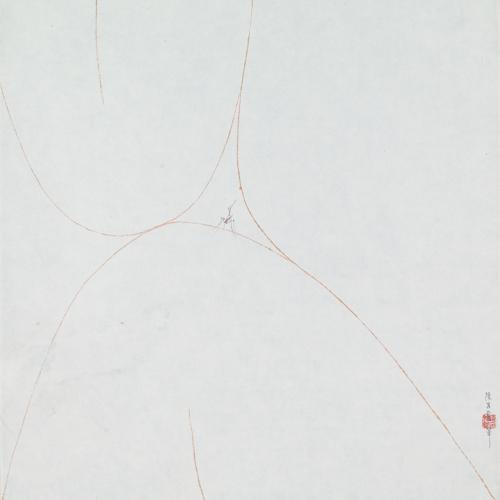陳其寬(1921-2007)以建築師為本業,從事水墨創作逾五十年,在各自領域皆扮演著舉足輕重的領先地位,其建築作品橫跨全球,其中的設計與空間布局思維,皆源自於東方哲學思想與水墨意境的再現,並結合包浩斯主義中所追求的極簡、實用且融合在地元素的精神,形成獨特的時代風格。
文字來源 :臺南市美術館
圖像來源 :陳其寬文教基金會
Chen Chi-Kwan (1921-2007) was a renowned architect by trade but engaged in ink painting for over fifty years. He played a significant role in both fields, achieving leadership status globally. His architectural works, spanning across continents, drew heavily from Eastern philosophical ideas and the aesthetics of ink painting. These influences merged with the minimalist, functional, and locally-integrated spirit of Bauhaus, culminating in a distinctive style that defined his era.
Source: Tainan Art Museum
image: Chen Chi Kwan Education and Culture Foundation

陳其寬以減筆線條勾勒出彎曲的手肘、膝蓋與身軀,形塑出人體蜷曲的姿態;畫面中央預留出弧形的三角空間,一隻蚊子停在膝蓋上,抬起雙腳正奮力吸食,呈現出逗趣的場景。此時的人體,彷彿成了昆蟲眼中無垠的宇宙空間,呼應著清代文人沈復《童趣》一文中將蚊蟲比擬為鶴,以小見大的世界觀。透過這幅畫作,我們得以深入思考物質世界的廣度和深度,並感受到萬物存在皆由相對而生的東方哲思
文字來源 :蕭楷競
圖像來源 :陳其寬文教基金會
Chen Chi-Kwan adeptly used minimalist lines to outline curved elbows, knees, and torsos, crafting the contorted postures of human bodies. At the center of the painting, an arched triangular space is intentionally left open, where a mosquito perched on a knee, actively feeding, creates a whimsical scene. In this moment, the human body becomes a boundless universe through the eyes of an insect, echoing the Qing dynasty scholar Shen Fu’s analogy of insects to cranes in his essay “Childlike Fun” (Tongqu), illustrating a perspective that sees the macrocosm in the microcosm. Through this artwork, we are invited to contemplate the breadth and depth of the material world and to appreciate the Eastern philosophical notion that all existence is interrelated and relative.
Source: Hsiao kai-Ching
Image: Chen Chi Kwan Education and Culture Foundation
